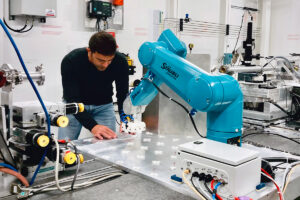High-throughput elemental analysis for the mining industry
A new system featuring a robot sample changer has been installed at the X-ray absorption spectroscopy beamline BM23 to enable researchers to scan thousands of samples per day with extremely low element detection limits.
The project was born out of a discussion between Manuel Muñoz, Professor at the University of Montpellier, and a partner in connection with a major company in the mining industry. Manuel Muñoz explained, “My associate told me of his dream concerning the trace element characterisation of mineral reserves, for tens of thousands of samples, which was, of course, unreasonable for existing characterisation techniques. I immediately had a concept in mind, telling him that maybe it could become possible…”
Four years later, the concept has been realised thanks to the collaboration with the ESRF and the STREAMLINE Horizon 2020 project. Its highly automated analytical approach is based on X-ray fluorescence. It will allow the mining industry to characterise trace element reserves with extremely low detection limits and for an unprecedented quantity of samples.
Due to the large amount of samples, the challenge was to improve the efficiency of the X-ray fluorescence measurement, as well as the experimental capacity through automation. Manuel Muñoz carried out some promising tests at BM23 and wrote the specifications for a system for high-throughput characterisation that could provide quantitative data, allowing very precise detection of contaminants. Thanks to the high flux of the new ESRF-EBS light source, the data collection speed and detection limits are unmatched.
When the STREAMLINE project began, a more rigorous and efficient way of making this solution available to all ESRF clients was investigated. A focus group was formed that brought together engineers from the ESRF and experts from the University of Montpellier. They aimed to refine the initial procedure and to build an automated system that could be made available to other users. ESRF experts involved in the project are Olivier Mathon, scientist in charge of beamline BM23, and Yves Watier and Johannes Frey, engineers in the ESRF Sample Environment Group. They developed a prototype of the sample handling system, which, following validation by the university, was installed at BM23.

Manuel Muñoz placing sample trays in the robot sample changer at BM23. © Chiara Facoetti
Ennio Capria, ESRF Business Development Office, describes the characteristics of the set-up, “The robot sample changer is a flexible tool that can be deployed to many different beamlines. It comprises a robotic arm and a laser system, the latter for precise positioning of the sample. A well-calibrated geometry is required to ensure a precise, reliable and reproducible configuration between the beam, sample and detector”.
The samples need to be stored in such a way as to allow the evolution of ore contents to be monitored periodically. A sample holder was specified by the focus group and a manufacturer was identified. The sample holder manufacturing process is cost-effective and there is a choice of reusable and disposable sample holders, the latter to avoid cross-contamination.
The equipment, hardware and data acquisition workflows are currently being commissioned, and a pilot run is ongoing. Production of the complete system will be the first milestone to be reached and enabled by the STREAMLINE project. More advanced data analysis tools remain to be put in place. Currently, the University of Montpellier can transform the raw data into a report for clients. The next challenge is to develop accelerated data analysis and advanced data reduction at the ESRF.
The new EBS synchrotron source makes it possible to reach detection limits down to the ppm level. The system that has been developed will provide interesting opportunities for industrial and academic users in the future, particularly in mining, chemistry and accelerated materials discovery.
Edited by Chiara Facoetti